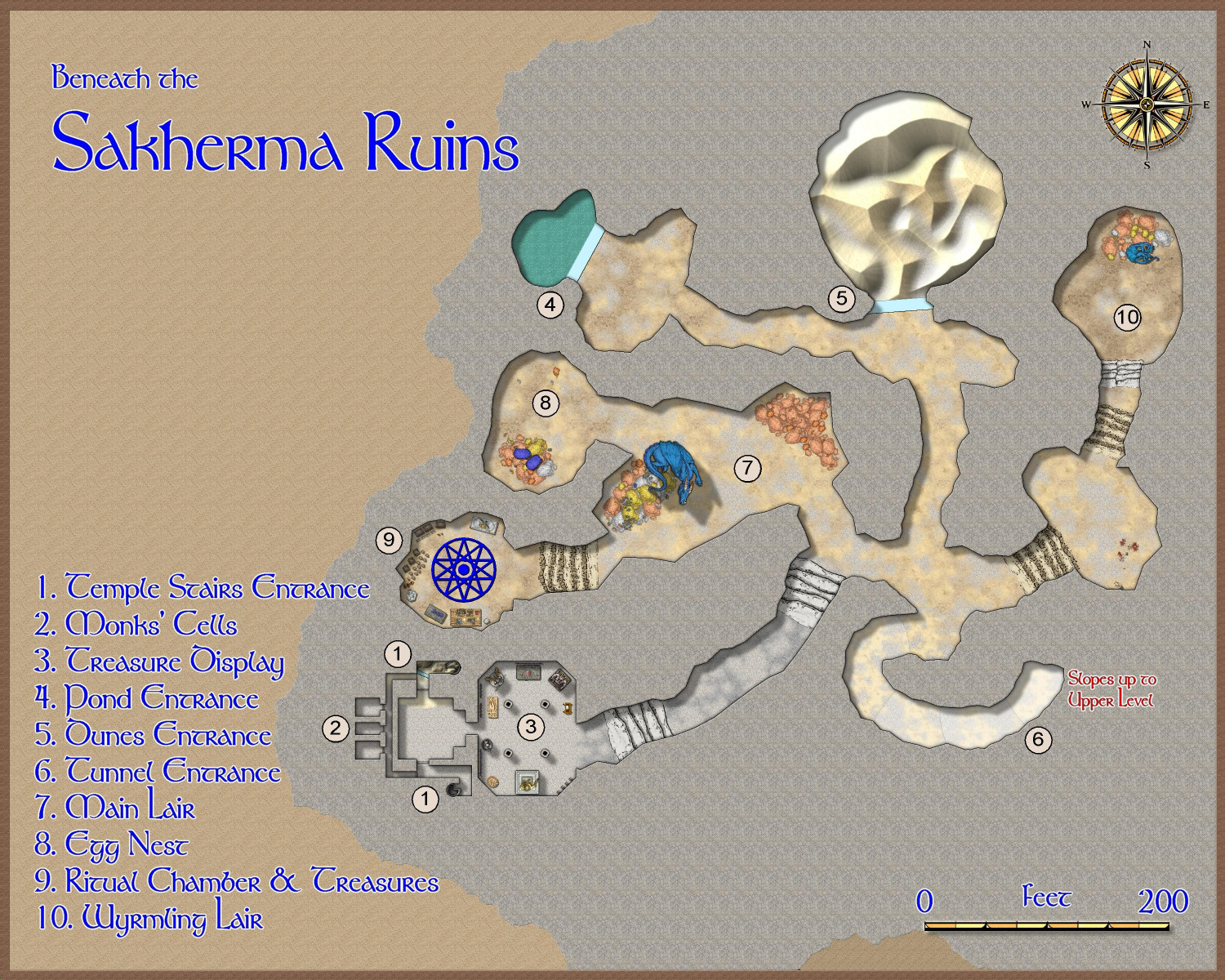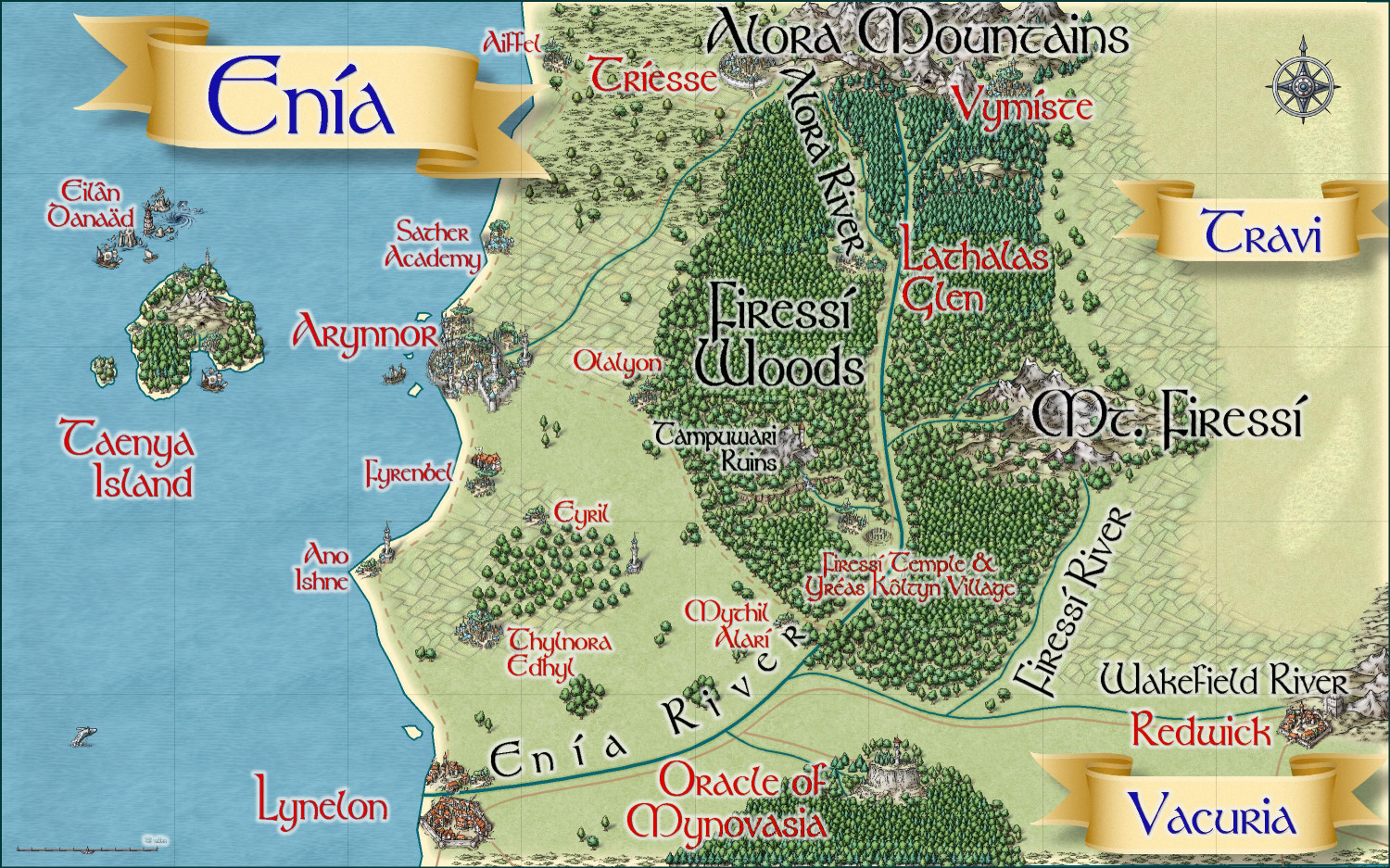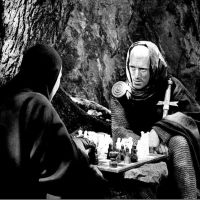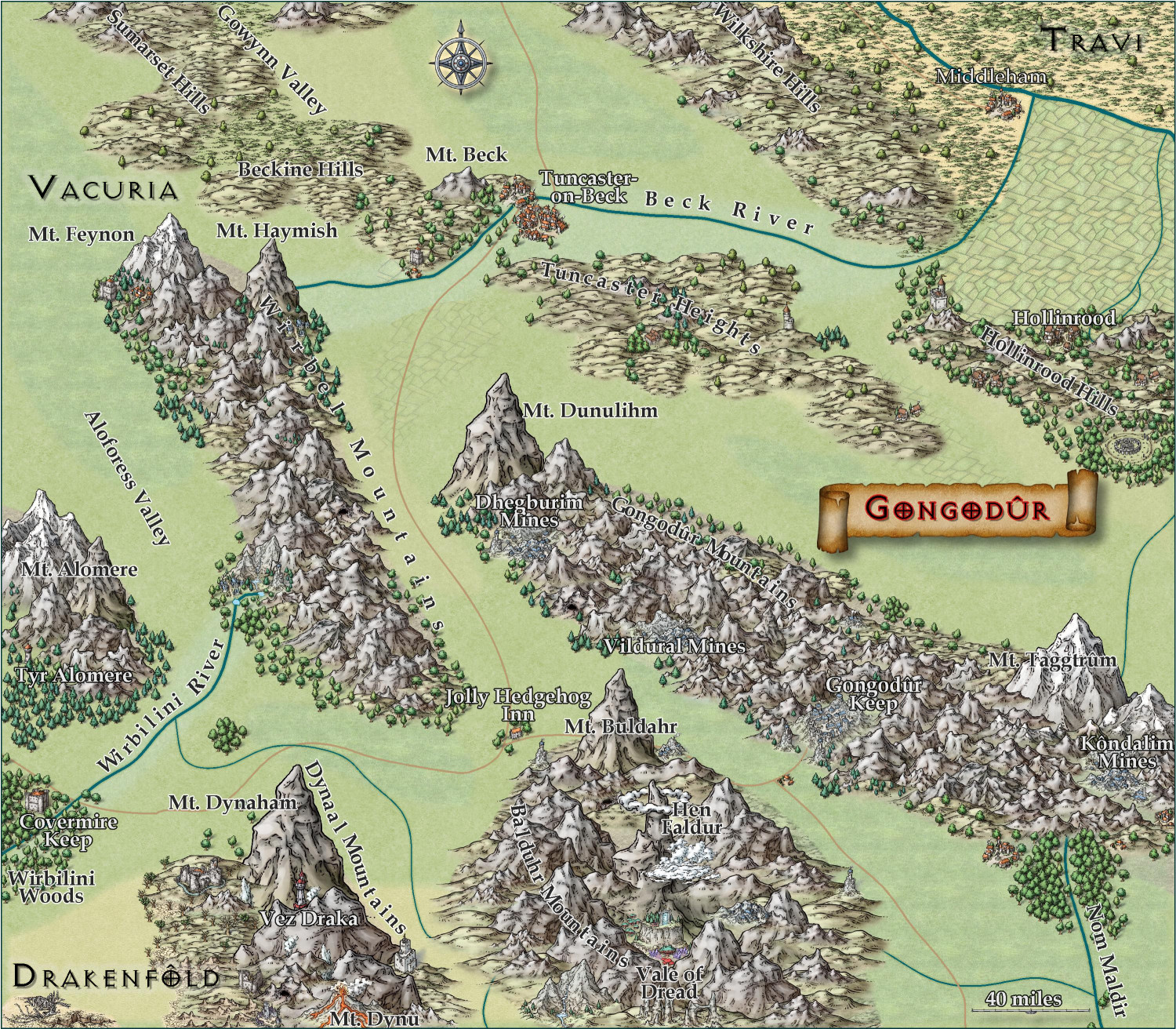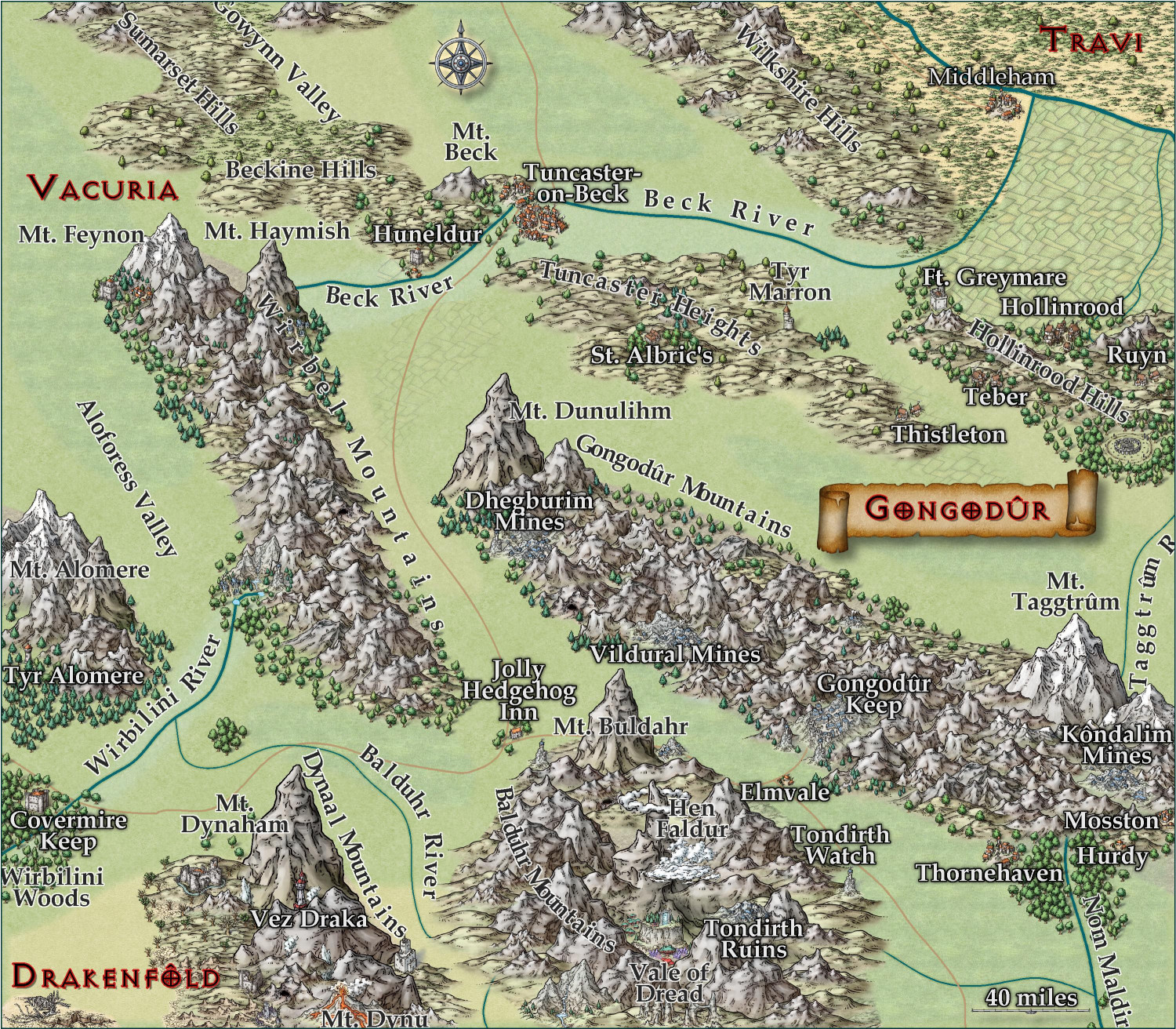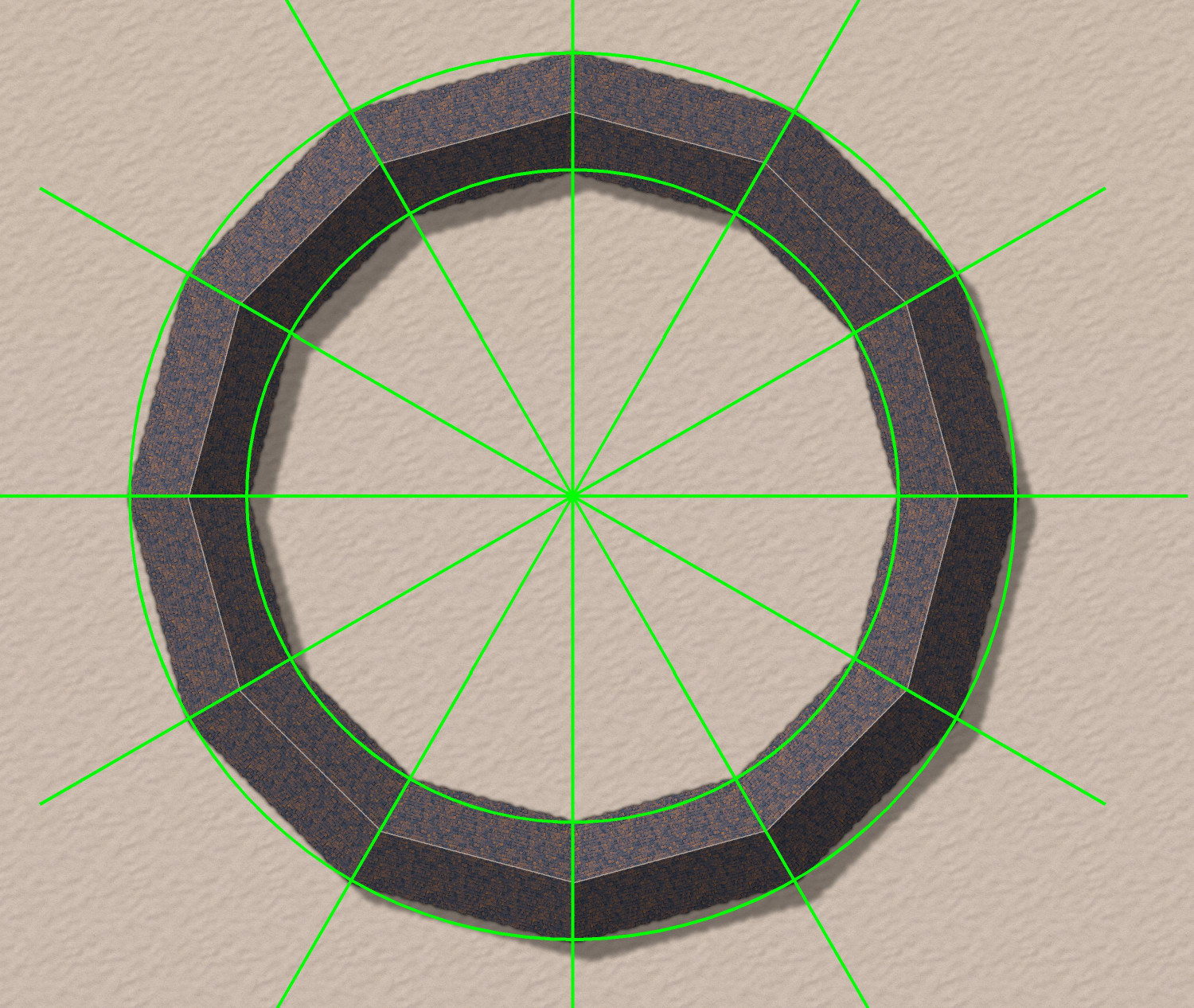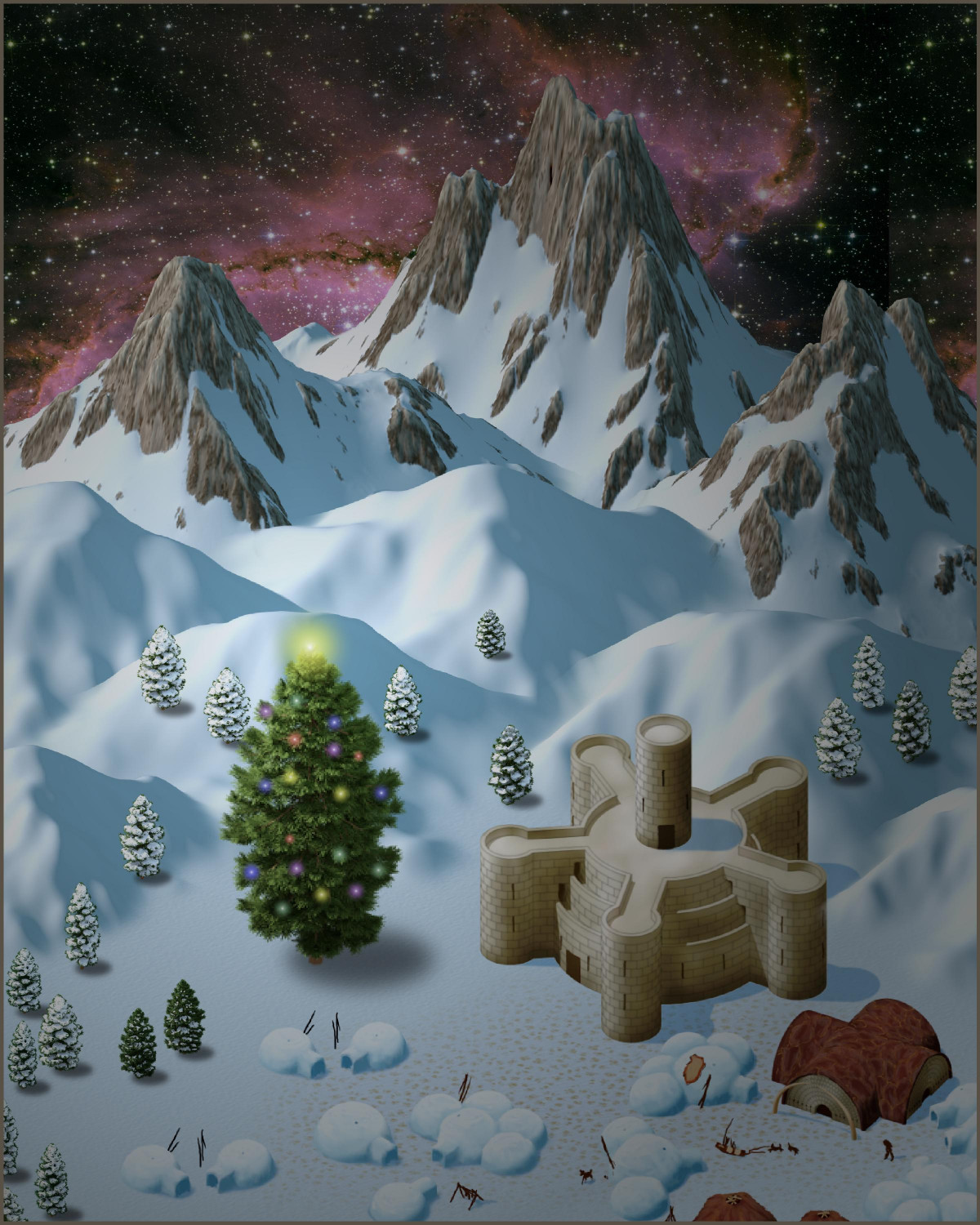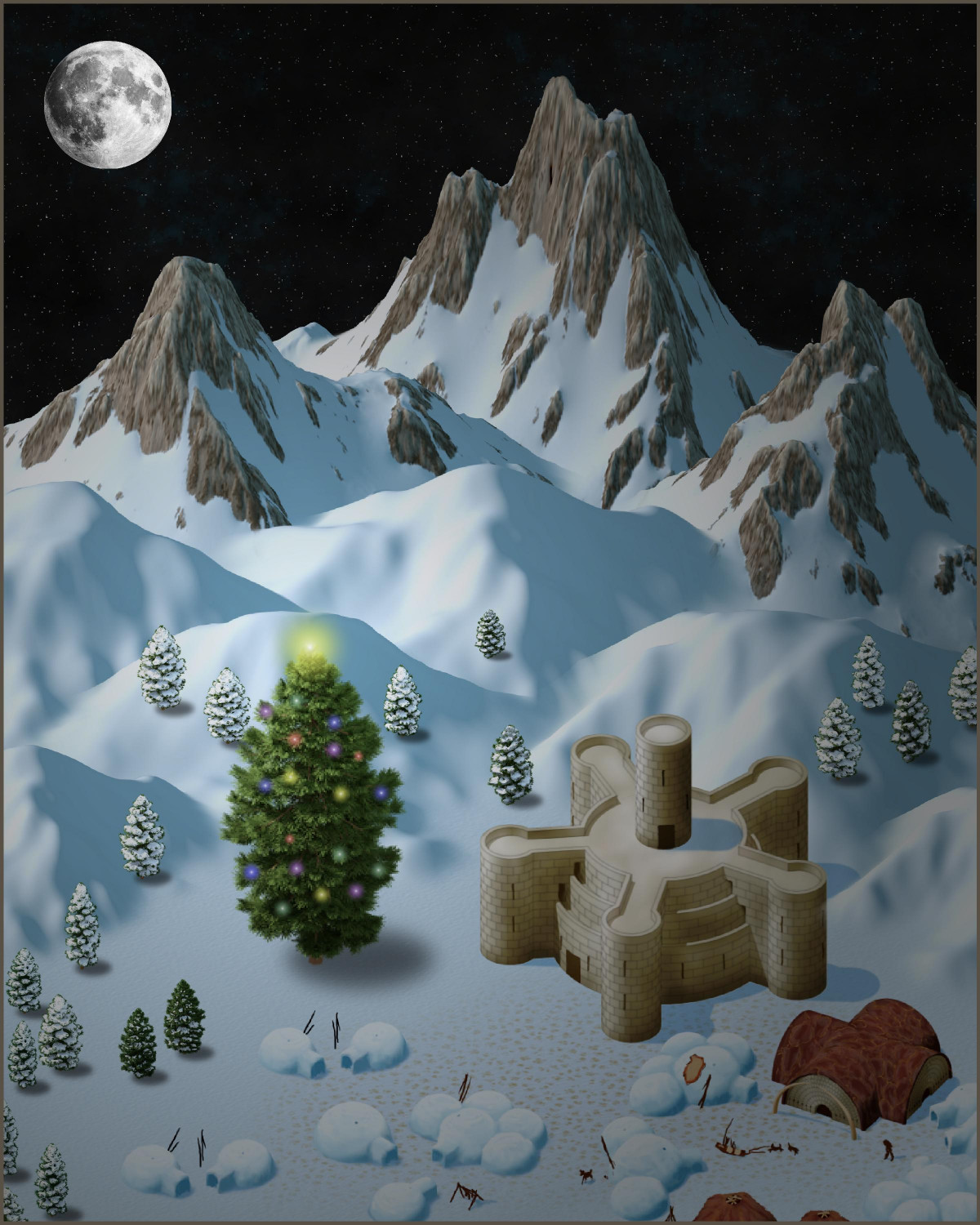Royal Scribe
Royal Scribe
About
- Username
- Royal Scribe
- Joined
- Visits
- 8,810
- Last Active
- Roles
- Member
- Points
- 3,198
- Birthday
- February 5, 1968
- Location
- San Francisco, California
- Real Name
- Kevin
- Rank
- Mapmaker
- Badges
- 16
Reactions
-
[Atlas Submission] - Doriant - Gold Coast - Eknapata Desert - Sakherma Ruins
Below
No toggles.
Description
Sakherma Ruins
Below
1. Temple Stairs Entrance: Here, the stairs from the temple ruins above descend to human-created chambers. The northern staircase is blocked by sand, but a glass wall keeps the sand from filling the chamber below. The southern staircase is relatively unobstructed.
2. Monks’ Cells: These three chambers appear to once have been home to the monks who maintained the original temple. Game Masters: At the Game Master’s discretion, one or more of these rooms may be occupied by the dragon’s humanoid allies – kobolds, dragonborn, or perhaps sorcerers with a draconic bloodline.
3. Treasure Display: This room is practically cluttered with statues and tapestries. Game Masters: Here the dragon has created a veritable museum showing off its favorite treasures, including a display of magical armaments.
4. Pond Entrance: At the base of the pond, a mighty glass wall keeps the pond’s water from flooding into the tunnels. Game Masters: The dragon can magically pass through the glass without harming it to bathe in the pond, or for another escape route to the outside surface.
5. Dunes Entrance: A great glass wall keeps the sand dunes from pouring into the caverns. Game Masters: The dragon can pass through the glass without harming it in order to reach the surface of the desert, or to devoir travelers camping there.
6. Tunnel Entrance: This tunnel connects the upper and lower caverns.
7. Main Lair: It is readily apparent, if visitors haven’t already figured it out, that this is a dragon’s lair. Piles of coins, particularly copper ones, form its bed.
8. Egg Nest: A blue dragon’s egg lies on top of a pile of coins infused with the dragon’s magic to keep the egg warm when the dragon is away.
9. Ritual Chamber & Treasures: Here the dragon keeps most of its magical treasures. The dragon may also shift into human form to conduct arcane rituals from time to time.
10. Wyrmling Lair: The bedroom for the dragon’s “teenage” child.
-
Community Atlas submissions: the Gold Coast (Doriant) and areas within it
I'm ready to submit this intermediate map for the Kingdom of Enía, along the northern edge of the coast for the parent map above. This map will be the parent (or possibly grandparent) for a few villages I will be submitting to the contest.
Primary Style: Mike Schley Overland
Toggles: BORDERS/POLITICAL to show/hide political borders
Here is the FCW along with a PDF of the description:
Should I do a plain text file that strips out the accent marks? Here's the text of the description (with accent marks):
The elven kingdom of Enía is the northernmost coastal kingdom in the Gold Coast region of Dórian. The human Kingdoms of Vacuria and Travi lie to the south and east, respectively. Enía is significantly smaller in both population and geographic size than its neighboring kingdoms. The kingdom’s borders are marked by the Enía River along its southern border, and the Firessí River and edge of the Firessí Woods along its eastern border.
Enía is governed by a hereditary monarch who is advised by two political bodies: the Council of Adept Mages, and the People’s Assembly. The Council of Adepts consists of those archmages and adept mages able to cast the most powerful spells. The People’s Assembly includes a hundred citizens elected throughout the realm.
Major points of interest include:
Arynnor: The capital of Enía, called the “city of glass.” Here, elves pioneered glassblowing techniques both for ornamentation and practical purposes. This includes a technique to make glass nearly as strong as steel, which has allowed the elves to safely cover their towers with brightly colored glass domes.
Sather Academy: To the north of Arynnor, Sather Academy is an institution of higher learning with academic classes of all sorts, from history to astronomy, poetry to accounting, but it is most famous for two things: its Bardic Colleges, and its Arcane Academy for the formalized study of wizardry and arcane lore.
Lynelon: The coastal city on the northern bank of the Enía River, Lynelon is a bit smaller than the Vacurian city of the same name on the southern bank.
Firessí Woods: Much of the realm is covered by a mighty forest, the Firessí Woods. The woods are home to numerous tiny elven hamlets along with a few notable features. Towards the southern edges of the Firessí Forest lies an ancient henge of standing stones, the Firessí Temple, erected to honor the elven gods. It is the holiest place in all of Enía, and the seat of power for the Archdruid of Firessí, the most powerful religious figure in the kingdom. A small village, Yréas Kôltyn, provides a home for the elves who tend to the temple and provides accommodations for the temple’s many pilgrims. To the northwest of the temple lies the Tampuwari Ruins, the haunted ruins of a people so ancient, they disappeared long before the elves moved to the area. The ruins are best to be avoided. Farther to the north, Lathalas Glen is a town built up around a monastery of the same name.
Taenya Island: The small island is home to a few small villages and hamlets of wood elves Just to the north of the island among rocky reefs, Eilân Danaäd is a harbor village of sea elves with homes both above and below the waves.
-
[WIP] Kingdom of Gongodûr
I changed the two labels to near-white for settlements and near-black for geographical names. (Let me know if you think I should reverse that, with dark names for settlements and light ones for geography.) Playing with text-along-a-curve for some mountain ranges and rivers, and moved some to the side to make them easier to read. (For a few of them, I had to explode the text and ungroup temporarily to adjust the kerning.) Made some effects changes to the political borders but I need to redraw them to reflect the river changes. Oh, and I embiggened the compass and moved it. It also has an inner glow to make it stand out a little.
May not have more time today to work on this -- about to head out to a family function for the day. Hoping to finish it this weekend.
-
[WIP] Kingdom of Gongodûr
Still working on this. Text is slightly larger, and the glow is as well. Added more names, though I still have a few more rivers and settlements to do. Should I be naming the roads, too?
I am think about putting country names, settlement names, and geographic names each on a separate layer so that end users can toggle them on and off as desired. They're already on separate sheets, though, so maybe that's sufficient for toggling individually, and a single layer for all of them to toggle all names on/off simultaneously?
-
Donut-shaped buildings?
-
WIP: My version of Royal Scribe's Most Excellent Wizard Tower
-
[WIP] The Toy-Maker's North Pole Workshop
Another holiday scene, this one a community of gnomes living near the North Pole working for a "jolly old elf" known as The Toy-Maker.
I have three versions: one daytime and two at night. One of the nighttime ones uses a galaxy background from one of the Cosmographer annuals (the bitmap file calls it "Hubble_Galaxy"), and the other uses a starfield background that comes with Cosmographer.
I may choose one of these to make into holiday cards. Does anyone have a favorite? Also, I put a tower on top of the castle to give it a little more, but does it look goofy there?
Daytime
Nighttime 1
Nighttime 2
-
[WIP] Temple of Déine ap Gáeth
Temple of Déine ap Gáeth
In the human religion of the Áes Camáir, Déine ap Gáeth is the fourth of the five children of Camáir, the Goddess of Dawn and the mother of everything.
Déine ap Gáeth, the Snow Queen of the Áes Camáir, is the goddess of winter and storms. She lives on remote, snow-capped mountain peaks in a palace made of ice that is shrouded in perpetual fog. She is generally depicted with white hair and pale skin, dressed in garments that are silver and white with ice-blue accents. Though she is sometimes shown clad in all-white furs, she is more often shown wearing light clothing more appropriate for the summer for someone not immune to the cold as she is. She is seen as aloof and though certainly not evil, at least somewhat indifferent to the effects of harsh winters.
She is accompanied by Nathairsioc, a draconic spirit of wind and ice who is about the size of a large cat. She is also the mother of the Four Winds, whose father is believed to be a powerful elemental creature from the Plane of Air, perhaps the raw element of air or even The Féth itself, the mysterious fog that surrounds the palaces of the Áes Camáir. The Four Winds, who are considered to be demigods, serve as messengers of the gods and occasionally as liaisons between the gods and mortals. Though the Winds are not worshipped individually and have no priests dedicated to serving them, they do have shrines dedicated to placating and honoring them. It is said that there may be some warlocks for whom they serve as Celestial or Djinn patrons.
Although Déine is worshipped everywhere where the Áes Camáir’s followers live, her monasteries and the temples attached to them are generally located in snowy alpine and arctic environments, where her monks and priests are trained to survive in cold environments without special attire.
The Festival of Déine ap Gáeth, or Fayluh Déine, is a gift-giving holiday that begins on the Winter Solstice. In the Common Calendar, it also now marks the beginning of the new year.
At this temple, a bridge spans a great crevasse to connect the temple with its monastery. A portion of the temple has been carved into an icy bluff. Years ago, a family of yeti accidentally broke through to a portion of the temple. The priests and monks were able to drive back the yeti, and have subsequently sealed off that portion of the temple.
1. Temple of Déine ap Gáeth: The temple for worshipping Déine ap Gáeth also includes a chapel for the worship of other Áes Camáir gods. Visitors typically worship here instead of the below-ice chapels. It also includes office space for the priests as well as living quarters for the most senior priests. The northern wing is buried in the icy cliffs, with a ceiling of ice about 20 feet above the roof of the temple, allowing for roof access beneath the ice. Two doors can be found in this wing. The northwest door provides access to a passage to a bridge, beyond which are tunnels extended for miles to a settlement of kobolds who some believe serve an old white dragon. The northeast door provides access to the subterranean portions of the temple. Another door on the southeast wing provides access to a road that winds around the rift. The primary entrance, however, is on an upper level reached from a bridge that spans across the crevasse to connect the temple with the monastery.
2. Monastery of Déine ap Gáeth: Here, monks and acolytes live and train for service to Déine ap Gáeth. From an upper level, a bridge extends across the crevasse to connect with the Temple.
3. The Great Crevasse: This massive rift in the ice and rock extends to unknown depths, and many have lost their lives falling in. Some claim that the rift provides access to the paraelemental plane of Ice, located on the border between the planes of Air and Water. Others claim that Déine’s own palace in the heavens can be accessed through the rift.
4. Reception Room: A gathering area for the below-ice temple. Though most of the below-ice temple has icy floors, this room has flagstone flooring.
5. Ice Chapel of Déine ap Gáeth: Religious services here are primarily for the priests and monks who live at the temple and monastery, as visitors generally worship in the anove-ground temple. An altar appears on a dais carved from ice, flanked by fonts of holy water on either side of the dais.
6. Hot Pool: Half of this oval-shaped room is used by a steaming pool as hot as any bath. The water is heated in pipes that extend from the Lava Room (#10). The floor is a white marble.
7. Ice Plunge: Once they have become warm in the hot bath or the saunas, some monks and priests like to plunge into a cold bath in this room, before returning to the saunas or baths to warm up again. The floor is blue tiles.
8. Steam Sauna: Water is poured over rocks heated by a brazier to provide for a warm, steamy environment.
9. Dry Sauna: No steam in this sauna, just a dry heat.
10. Lava Room: A tiny crevasse reveals a pit of lava that is used to heat the hot pool and saunas.
11. Office of the High Priestess: The high priest or (currently) priestess has an office here as well as in the main temple. This office is primarily used for changing into vestments before religious ceremonies.
12. Monks’ Rooms: Monks and acolytes who have completed their education typically spend a month living in these icy rooms before taking their final vows.
13. Chapel of the Four Winds: The Four Winds are sons of Déine ap Gáeth, demigods who serve as messengers of the gods. This main room has branches along the cardinal compass points to smaller shrines for each Wind.
14. Shrine of Anair ap Gáeth, the East Wind: Anair ap Gáeth, the East Wind, is seen as a bringer of warm rains. He is associated with the summer.
15. Shrine of Faitse ap Gáeth, the South Wind: Faitse ap Gáeth, the South Wind, is associated with the desiccating, hot wind of late summer and autumn.
16. Shrine of Íarus ap Gáeth, the West Wind: Íarus ap Gáeth, the West Wind, is the most gentle and favorable of the winds. He is associated with flowers, springtime, and procreation. In myths, he is presented as the tender breeze,
17. Shrine of Túaiscert ap Gáeth, the North Wind: Túaiscert ap Gáeth is the cold wind from the north. He is associated with storms and winter. He is depicted as being very strong, with a violent temper to match.
18. Fire Trap: Two locked stone doors block access to this room, once a storage room before the yeti broke through to this part of the temple. The priests have also added a Glyph of Fire here to keep the yeti at bay.
19. Blocked Chamber: In this chamber, the priests have used their divine powers to bring down an avalanche of icy rocks to block access to the yeti family’s home.
20. Yeti Lair: A family of yeti are believed to still dwell in these icy caves.
21. Yeti Exit: A passageway extends for nearly a mile below the ice before providing an exit. This allows the yeti to come and go while avoiding the priests who wield fire to keep them at bay.
22. Passageways to the Ice Kobolds: These passageways extend for many miles before reaching a settlement of kobolds who are said to worship or serve an old white dragon. The priests of Déine ap Gáeth have reached a truce with the kobolds, and occasionally trade goods and services with them.
-
[WIP] Swamp Witch
When I was coming up with "spooky season" mapping ideas, I was debating between a haunted house or a witch's lair in a swamp. Why not both?
That required experimenting with some different styles to try to create a swamp. (Let this serve as another plug for a jungle/swamp annual compatible with annuals like Creepy Crypts, Forest Trail, and Marine Dungeons.)
I wasn't sure which way to go...so I ended up doing three versions. One is in the Mike Schley Dungeon (SS4) style, the second used Forest Trails as the basis, and the third used Marine Dungeons (though the second two had to borrow a bit from DD3 and other styles).
I don't know a lot about swamps, but the images I've seen show a lot of trees both on dry land and in the water. In all three versions, I made it so that the tree tops could be hidden, both to create a battlemap version and also to show that some of the trees were growing out of the water and not just from patches of solid land.
Here are all three side by side, and then in the comments I will show each one in more detail.
-
A small carpenter store


